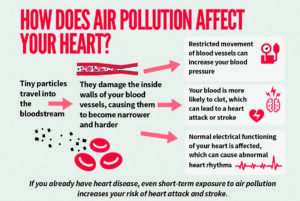
Air pollution is the name given to pollutants in the air that can harm health if they are breathed in. They are small particles also known as particulate matter, or PM), or gases like nitrogen dioxide, ozone, sulphur dioxide and carbon monoxide.

The various sources of Pollution in air are diesel and petrol vehicles , fumes from factories and power plants farming (from fertilisers and animal manure) burning firewood, candles or incense indoors smoking cigarettes indoors. However air pollution can come from natural sources, for example soil, pollen, volcanoes and sandstorms.
Particulate matter or particle pollution (PM) is a mixture of solid particles and liquid droplets found in the air. Some particles, such as dust, dirt, soot, or smoke, are large or dark enough to be seen with the naked eye. Others are so small they can only be detected using an electron microscope. Example of Particle pollution are:
PM10: inhalable particles, with diameters that are generally 10 micrometers and smaller; and
PM2.5: fine inhalable particles, with diameters that are generally 2.5 micrometers and smaller. Some are emitted directly from a source, such as construction sites, unpaved roads, fields, smokestacks, or fires. Most particles form in the atmosphere as a result of complex reactions of chemicals such as sulfur dioxide and nitrogen oxides, which are pollutants emitted from power plants, industries, and automobiles.
Air pollution can damage blood vessels by making them narrower and harder leading to increased clot formation tendency, increased blood pressure increases the strain on your heart muscle. It can affect the heart’s electrical system which controls heartbeat. This can cause abnormal heart rhythms. Changes can be seen as in early stages of heart failure.
For people with previous heart diseases, this damage can increase their risk of events like a heart attack.
Exposure to air pollutants – even at levels below World Health Organization air quality guidelines – may trigger a heart attack within the hour, according to a new study from China that found the risks were highest among older people and when the weather was colder.
Any concentrations of air pollutants (such as fine particulate matter, nitrogen dioxide, sulfur dioxide and carbon monoxide) may have the potential to trigger the onset of a heart attack.”

Exposure to fine particulate matter – microscopic solids or liquid droplets from automobile emissions, power plants, construction sites and other sources of pollution – has been linked to heart disease, stroke and other health issues, as well as 4.2 million premature deaths worldwide. These particles can be so small that when inhaled, they may go deep into the lungs or even the bloodstream. How to reduce exposure to air pollution. Strategies include closing windows and using portable air cleaners and built-in air conditioning filters, as well as personal air-purifying respirators that cover the nose and mouth for people at high risk. Properly fitted masks, such as those used to prevent the spread of COVID-19, also can help. N95 masks are very good at reducing particulate exposures. They will stop you from inhaling them.”
The author is an Interventional cardiologist at Sir Gangaram hospital New Delhi.















